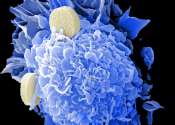Popular diabetes drugs do not increase thyroid cancer risk, study suggests
Drugs known as GLP-1 analogs have become increasingly popular to treat diabetes and obesity, but there have been concerns that they might increase the risk of thyroid cancer. Now an extensive Scandinavian study led by researchers ...
Apr 9, 2024
0
28









